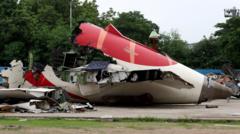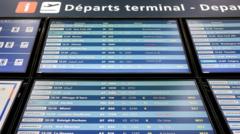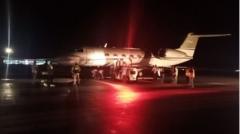London's Heathrow Airport, a vital global travel hub, experienced a significant shutdown early Friday, impacting 120 flights already en route. This sudden halt requires planes and cargo destined for Heathrow to land elsewhere, igniting a frantic search for hotel accommodations for displaced passengers. According to Ian Petchenik, communications director at flight-tracking service Flightradar24, managing this situation involves “a million moving pieces.”
Typically handling around 1,300 flights daily from over 80 different airlines, Heathrow’s shutdown left numerous aircraft scrambling for alternative landing sites. While some flights were rerouted to London’s Gatwick, Birmingham, or Manchester airports, others were diverted to international locations such as Amsterdam or Frankfurt. A flight from New York’s Kennedy International Airport found itself unexpectedly landing in Reykjavik, while travelers from Tokyo redirected to Helsinki.
In Taiwan, the day’s only scheduled flight to Heathrow, delays became apparent shortly after departure when it turned back less than a couple of hours later. The chaos resulted in a worldwide scramble for alternate travels, as passengers sought to reach pending business meetings, family gatherings, or sightseeing excursions.
Airport officials in London anticipate that the disruption will extend for several days, and airlines brace for the daunting challenge of rebooking hundreds of thousands of affected travelers. Mr. Petchenik highlighted the unprecedented nature of the closure—a rare incident akin to the 2010 Iceland volcano eruption, which grounded over 100,000 international flights for days on end.
As the situation develops, both airlines and travelers are faced with a complex logistical challenge to restore order amid significant travel disruptions.
Typically handling around 1,300 flights daily from over 80 different airlines, Heathrow’s shutdown left numerous aircraft scrambling for alternative landing sites. While some flights were rerouted to London’s Gatwick, Birmingham, or Manchester airports, others were diverted to international locations such as Amsterdam or Frankfurt. A flight from New York’s Kennedy International Airport found itself unexpectedly landing in Reykjavik, while travelers from Tokyo redirected to Helsinki.
In Taiwan, the day’s only scheduled flight to Heathrow, delays became apparent shortly after departure when it turned back less than a couple of hours later. The chaos resulted in a worldwide scramble for alternate travels, as passengers sought to reach pending business meetings, family gatherings, or sightseeing excursions.
Airport officials in London anticipate that the disruption will extend for several days, and airlines brace for the daunting challenge of rebooking hundreds of thousands of affected travelers. Mr. Petchenik highlighted the unprecedented nature of the closure—a rare incident akin to the 2010 Iceland volcano eruption, which grounded over 100,000 international flights for days on end.
As the situation develops, both airlines and travelers are faced with a complex logistical challenge to restore order amid significant travel disruptions.























